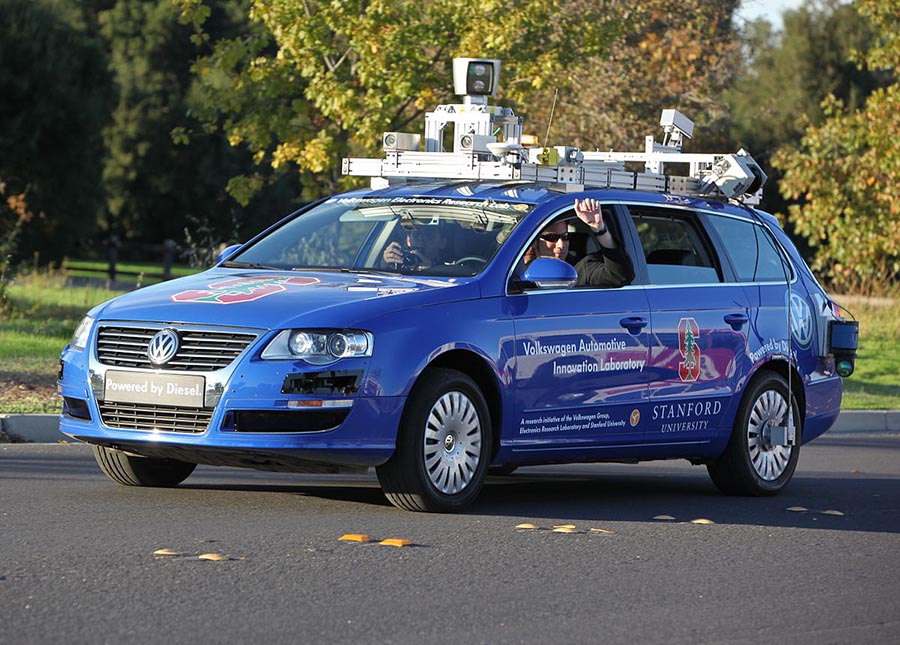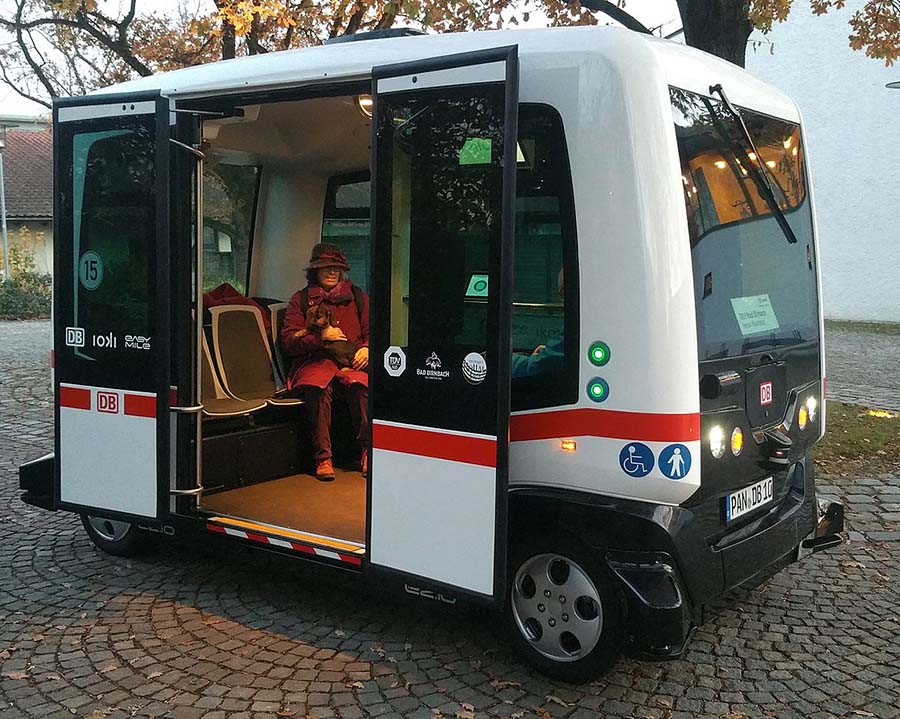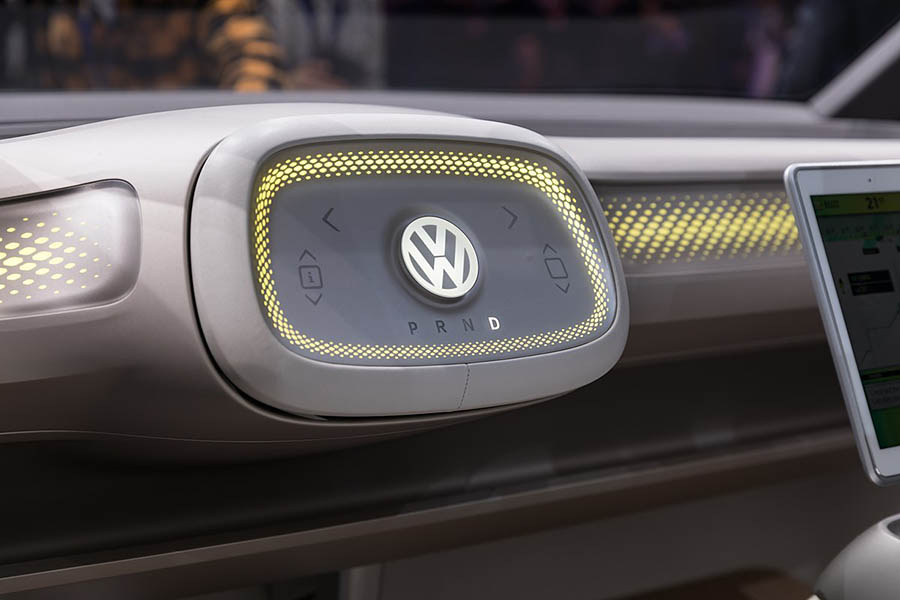A self-driving motor vehicle (sometimes also an autonomous vehicle ) is a car or other motor vehicle that can drive, control and park without the influence of a human driver (highly automated driving or autonomous driving).

In the event that no manual control by the driver is required, the term robot car is also used. Then the driver’s seat can remain empty; the steering wheel, brake and accelerator may not be available. Fully autonomous land vehicles are currently only available as prototypes. The automotive industry, several IT companies, and other groups are working on making this possible for the market as series production. Waymo and Tesla are considered to be the most advanced.
Overview
The term “self-driving motor vehicle” also includes trucks, agricultural tractors and military vehicles without driver influence or without a driver at all. An unmanned vehicle is not referred to as an “autonomous land vehicle” if it has to be remotely controlled by people, i.e. if it cannot drive autonomously. The term “self-driving car (mobile) ” is strictly a tautology, because the term “automobile” originated from Greek word αὐτός meaning ‘itself’ and Latin word mobilis, meaning mobile.
Autonomous motor vehicles are cognitive systems that use various sensors to perceive their surroundings and determine their own position and that of other road users from the information obtained. In cooperation with the navigation software, you can go to the destination and avoid collisions on the way. Many large car manufacturers around the world are currently investing in the development of autonomous cars, while the electronics and semiconductor industries are driving the development of technologies for this.
In 2013, various automation levels predicted that new vehicles would be fully automated by 2030, for which legal regulations were to be created in the individual countries by then. As a start for the mass market, Google co-founder Sergey Brin had already specified the destination for the United States in 2017. Elon Musk from Tesla Motors forecast a fully autonomous vehicle for 2020 in 2015. In 2016 BMW and Ford announced autonomous vehicles from their production for the year 2021. VW and Ford have formed a new alliance.
Development
University Institutions
As early as the 1990s, the Munich University of the Bundeswehr had vehicles driven by driverless vehicles within the EUREKA PROMETHEUS project that it started in the 1980s. These operate solely on the basis of visual information, supplied by various cameras that were processed by 70 microprocessors working in parallel.
The American Carnegie Mellon University also built driverless cars and other vehicles in the 1980s, from the mid-1980s in the Autonomous Land Vehicle project sponsored by DARPA.
For a long time there has been numerous research work at universities and other academic institutions on autonomous vehicles, for example in 2011 the projects “Stadtpilot” at the TU Braunschweig and “Spirit of Berlin” in the research area “Artificial Intelligence” at the Free University of Berlin.

In September 2011, the autonomous vehicle “MadeInGermany” was tested by the Free University of Berlin. It drove itself several kilometers through the inner city traffic of Berlin, also via roundabouts and traffic lights. The route was developed in cooperation with TÜV Nord and a safety concept was created.
Intensive and comprehensive research has been carried out for several years in order to better understand and advance the challenge.
The search engine company Google has been working with automakers and universities for years and dedicated in 2003 to the German computer scientist Sebastian Thrun, who at that time was just a professor at the Stanford University.

Since the end of 2017, Waymo, which was founded to continue development work, has been testing the first fully autonomous cars without safety drivers at the wheel near Phoenix, Arizona. However, a Waymo employee can stop the car from the back seat in the early stages. This should be dropped later. The company itself classifies the system as “Level 4” at the level of autonomous driving.

Automakers
The Volvo “Drive Me” project in Gothenburg has been in the development phase since April 2014.
In the summer of 2013, a Mercedes S-Class autonomously drove the historic Bertha-Benz route from Mannheim to Pforzheim in the presence of journalists, with the exception of two human interventions. In 2014, an Audi-made car drove autonomously around 900 kilometers from Silicon Valley to Las Vegas.

There are also production cars from Daimler, Honda and Nissan that can drive on motorways themselves. The technology called Traffic Jam Assistant, however, only allows a speed of up to 60 km/h. The traffic jam assistant is activated automatically if the driver does not touch the steering wheel for more than 10 seconds, but usually cannot change lanes independently.
Since a software update in October 2015, the Tesla Model S has been able to drive autonomously on motorways and also change lanes. The driver does not have to operate the steering wheel, accelerator or brake.
Daimler has been testing self-driving trucks on the public roads in Nevada, USA, since May 2015. In the United States, self-driving vehicles (such as the Inspiration Truck) are already registered under certain conditions, but not in Germany.
Since October 2015, Nissan has been testing a self-driving car based on a Nissan Leaf and developed in cooperation with NASA. Various functions are now to be tested on the road. Initially, however, only on motorways and only from 2018 with the ability to change lanes. Tests on city streets are planned for 2020. The car has a laser scanner with 3D measurement and an 8-way camera with a 360-degree view. This is to improve security.

In 2016, BMW announced an alliance with Intel and Mobileye, with the aim of launching a driverless car in series in 2021. In Sion, Switzerland, there has been an experimental regular operation with the autonomous Arma shuttle bus of the French company Navya since June 2016; Since September 2016 also in Lyon, France.
Since October 2016, all Tesla vehicles have been delivered with hardware that allows the vehicles to be fully autonomous in the future, i.e. to drive according to SAE Level 5. For the time being, the system will run in a so-called shadow mode, i.e. without interfering with driving and sending the collected data back to Tesla to gradually improve the capabilities of the system until the system is ready for release through an over-the-air upgrade. Tesla announced that the fully autonomous state would be reached in late 2017. Then a demonstration trip from San Francisco to New York would be planned, in which a Tesla vehicle should cover the route unmanned (which did not happen). As of May 2020, Tesla hasn’t activated fully autonomous features that does not require human input.
In October 2018, Toyota and Softbank announced the creation of Monet Technologies as a joint venture.
Easymile is another manufacturer from France.
Automotive suppliers
Numerous automotive suppliers develop components and (sub) systems for the self-driving vehicle. This is done partly in cooperation with automobile manufacturers and research institutions as well as in the context of their own projects. The supplier Continental, for example, is working with several partners on a pilot project for autonomous driving. Bosch has been working on self-driving vehicles since 2014.
Standardization
- The OpenADx Working Group is a cooperation of the automotive industry initiated in June 2019, which should take care of things like better compatibility, interfaces and broader interoperability in the development of software that supports autonomous driving.
- Automotive Grade Linux is a collaborative open source project that brings together automakers, suppliers, and technology companies to accelerate the development and rollout of a fully open software stack for the connected car. With Linux at its core, AGL is developing from the ground up an open platform that can serve as a de facto industry standard to enable the rapid development of new functions and technologies.
- BSI Publicly Available Specifications (PAS): PAS 1880 and PAS 1881 related to the safety of automated vehicle development and testing. These are expected to be published in 2020.
- Draft UL 4600 standard that describes a safety approach to ensuring autonomous product safety in general and self-driving cars in particular.
- C2X communication according to the European ITS-G5 standard, especially 5G Automotive Association.
- The RAND Corporation has created a concept (framework) for the measurement and development of safety for autonomous vehicles.
- Safety First for Automated Driving (SaFAD) – 11 companies from the entire spectrum of automotive and automated drive technology have developed and published an industry-wide definition of safety for SAE J3016 Level 3,4 or autonomous vehicles.
- The Association for Standardization of Automation and Measuring Systems (ASAM) is an association for standardization and takes into account software and also the development of standards for autonomous vehicles.
Legal bases and social debate
The international convention on road traffic of the United Nations (Vienna Road Traffic Convention 1968) requires that “every vehicle and connected vehicles, when they are in motion, must have a driver (driver) “. Therefore, self-driving motor vehicles are currently not permitted – at least in the states that have ratified the UN Convention (however, driver assistance systems have been permitted since 2014). To date, no member country has made reservations about this clause.
Countries that have not signed the UN Convention, including the United States and the People’s Republic of China, are not bound. In Europe, only Spain has not ratified the convention.
Advantages
According to a study by the RAND Corporation, the advantages that autonomous vehicles bring with them far outweigh the possible disadvantages. The technology would make road traffic safer, since 90 percent of all accidents can be attributed to human error. This would mean economic savings of over 400 billion US dollars for the United States alone, according to the RAND Corporation. Peter Fuss from the Ernst & Young management consultancy believes that the number of fatalities could be reduced to zero.
Daniel Göhring from FU Berlin estimates that robot taxis would only need 20 percent of today’s cars in the city. In addition, the distances between the vehicles would be reduced. This would lead to a significant reduction in emissions and congestion. According to a study by the Lawrence Berkeley National Laboratory, an autonomous and electric robot taxi would produce around 90 percent less carbon dioxide in 2030 than a car with an internal combustion engine today.
In autonomous vehicles, drivers can deal with other things, e.g. reading. In addition, technology could also enable older people to participate socially in society through cheap mobility.
Dissadvantages
Uncertainties regarding data protection and the risk posed by cyber criminals are often mentioned as possible disadvantages. Accidents due to software errors are not excluded.
At the beginning of 2015, German Federal Transport Minister Alexander Dobrindt announced the establishment of a pilot project “Digital Test Field Highway ” on the A9 motorway in Bavaria. The test track was digitized and technically equipped so that there were additional offers for communication between road and vehicle as well as from vehicle to vehicle. There, both cars with assistance systems and later fully automated vehicles could drive. Transport Minister Dobrindt (CSU) sees the experiences made there in the test positively and wants to provide around 80 million euros for the expansion of new test routes in Germany. The costs of setting up the further German road network for automated and connected driving remain unknown. The order of magnitude has also not yet been named.
Ethical issues
Since there can also be situations in which autonomous / self-driving cars can cause accidents with personal injury, it must be decided in advance which behavior should the vehicle follow in such situations. A human driver would react instinctively in a sudden situation, for example when a child is walking on the street, without being aware of all relevant factors (such as the people on the sidewalk). He will not be able to make considerations about what action is morally justifiable. However, this does not apply to autonomous / self-driving cars. The decision as to how the vehicle should behave in which situation is made long before a possible accident. For example, the following questions arise:
- Can a machine evaluate the situation correctly at all, for example distinguishing between a doll’s pram and a real pram?
- Would a set-off of human lives ( utilitarian ) represent an unreasonable instrumentalization of the “victims”?
- If it would make sense to set it up, how is this to be organized, i.e. which criteria play a role (e.g. the number of people or the age)?
The latter question in particular is the subject of current research. The more practical a possible programming (in moral questions) of a machine becomes, the more problems accumulate.
In 2019, an estimated 38,800 people lost their lives to car crashes in the United States. It can be expected that driving a high proportion of autonomous vehicles would make driving safer. However, if the social discourse on self-driving cars should come to the conclusion that no preprogrammed response to situations in which accidents have become inevitable can be justified, the question would be inevitably to what extent current practice can be legitimized.
Resource consumption
It is often predicted that after the market launch of self-driving cars, some of the car owners would give up their car in order to switch to self-driving taxis that were cheaper for them. This should lead to fewer cars overall, but each would be more on the road than before. Currently, cars are parked most of the time and use up parking space. Free parking space would create more space for apartments, parks and roadways. Current simulations and projections investigate the possibilities of self-driving taxis or car sharing vehicles.
Accidents
An Uber car killed a pedestrian on March 19, 2018 in Tempe, Arizona, United States. The 49-year-old Elaine Herzberg pushed her bicycle across the street in front of the Volvo SUV. According to initial police investigations, Uber was found not guilt; the accident would have been difficult to prevent even with a human driver.

Later, Reuters reported, citing a police report, that the driver may have been distracted by a television program. It was the first fatal accident with a car of autonomy level 4, in which the driver only has to intervene in an emergency and after the car has warned. The Arizona governor has suspended Uber test drives on public roads. The police released video of the accident was alarming and raised many questions, Governor Doug Ducey wrote in an open letter to Uber chief Dara Khosrowshahi. The prosecutor’s office is investigating the incident.









